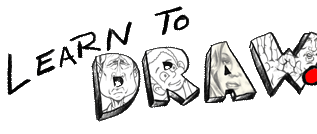|
 Let's take a look at how I drew the dude with the
shades. First, I think it's a good idea that when you
draw a portrait you should do a light contour sketch of
the main features like the eyes, nose, mouth, hairline,
and a contour of the head. If you do all your measuring
with this contour sketch, and get all your proportions
correct, all you have to do to finish the drawing is
shading. If you work out all the features that will get
"squished" with the contour sketch, you won't be doing
too much erasing after you've put in the shading. Let's take a look at how I drew the dude with the
shades. First, I think it's a good idea that when you
draw a portrait you should do a light contour sketch of
the main features like the eyes, nose, mouth, hairline,
and a contour of the head. If you do all your measuring
with this contour sketch, and get all your proportions
correct, all you have to do to finish the drawing is
shading. If you work out all the features that will get
"squished" with the contour sketch, you won't be doing
too much erasing after you've put in the shading.
 I did all the basic measurements and used his right eye
as my standard unit of measurement. Some of the unusual
measurements I took because of the three quarter view
were: From the corner of his right eye to the front of
his ear, and found that it was about the length of the
right tear duct to the outside corner of the left eye.
From the edge of the left nose lobe to the outside edge
of the left cheek, was about on eye wide. I found that
this photo is shot from an angle so that the camera is
looking down on him, and because of that the eyes were
NOT at the midpoint of the head, but slightly below. I did all the basic measurements and used his right eye
as my standard unit of measurement. Some of the unusual
measurements I took because of the three quarter view
were: From the corner of his right eye to the front of
his ear, and found that it was about the length of the
right tear duct to the outside corner of the left eye.
From the edge of the left nose lobe to the outside edge
of the left cheek, was about on eye wide. I found that
this photo is shot from an angle so that the camera is
looking down on him, and because of that the eyes were
NOT at the midpoint of the head, but slightly below.
 Once I got all the measurements correct and I liked the
lines I had drawn, I put a neutral tone lightly across
the whole face. I also did some initial shading of areas
that I knew would be darker than the neutral gray. This
made the face look a bit darker than it looked in the
photo, but I figured that was because the hair on my
drawing was white which made the skin look darker than
normal. I figured once I colored in the hair, the face
would look better. Once I got all the measurements correct and I liked the
lines I had drawn, I put a neutral tone lightly across
the whole face. I also did some initial shading of areas
that I knew would be darker than the neutral gray. This
made the face look a bit darker than it looked in the
photo, but I figured that was because the hair on my
drawing was white which made the skin look darker than
normal. I figured once I colored in the hair, the face
would look better.
 I had some trouble getting the glasses the shape I
wanted them, but I finally got it. I continued to shade
things in, putting darker shadows on the left side of
the face. I shaded in the hair, and because of the crew
cut, it was a lot like drawing short facial hair. I
added a little bit of the shirt collar. I had some trouble getting the glasses the shape I
wanted them, but I finally got it. I continued to shade
things in, putting darker shadows on the left side of
the face. I shaded in the hair, and because of the crew
cut, it was a lot like drawing short facial hair. I
added a little bit of the shirt collar.
 When I finished it up, I noticed that his left cheekbone
seemed to come out a bit too far, so I chopped a little
bit off by erasing away some of the gray tone. After
sketching in his hair (using short strokes to emulate
his crew cut), it did seem to lighten up his face. When I finished it up, I noticed that his left cheekbone
seemed to come out a bit too far, so I chopped a little
bit off by erasing away some of the gray tone. After
sketching in his hair (using short strokes to emulate
his crew cut), it did seem to lighten up his face.
If, in your photo, the background is darker than your
subject's face, the drawing may look a bit too dark
unless you tone the background of your drawing to be
darker than the face. The tone you draw may be exactly
right, but it might seem too dark because of your white
paper background.
Let's next look at some facial variations and how you
would draw them. |
